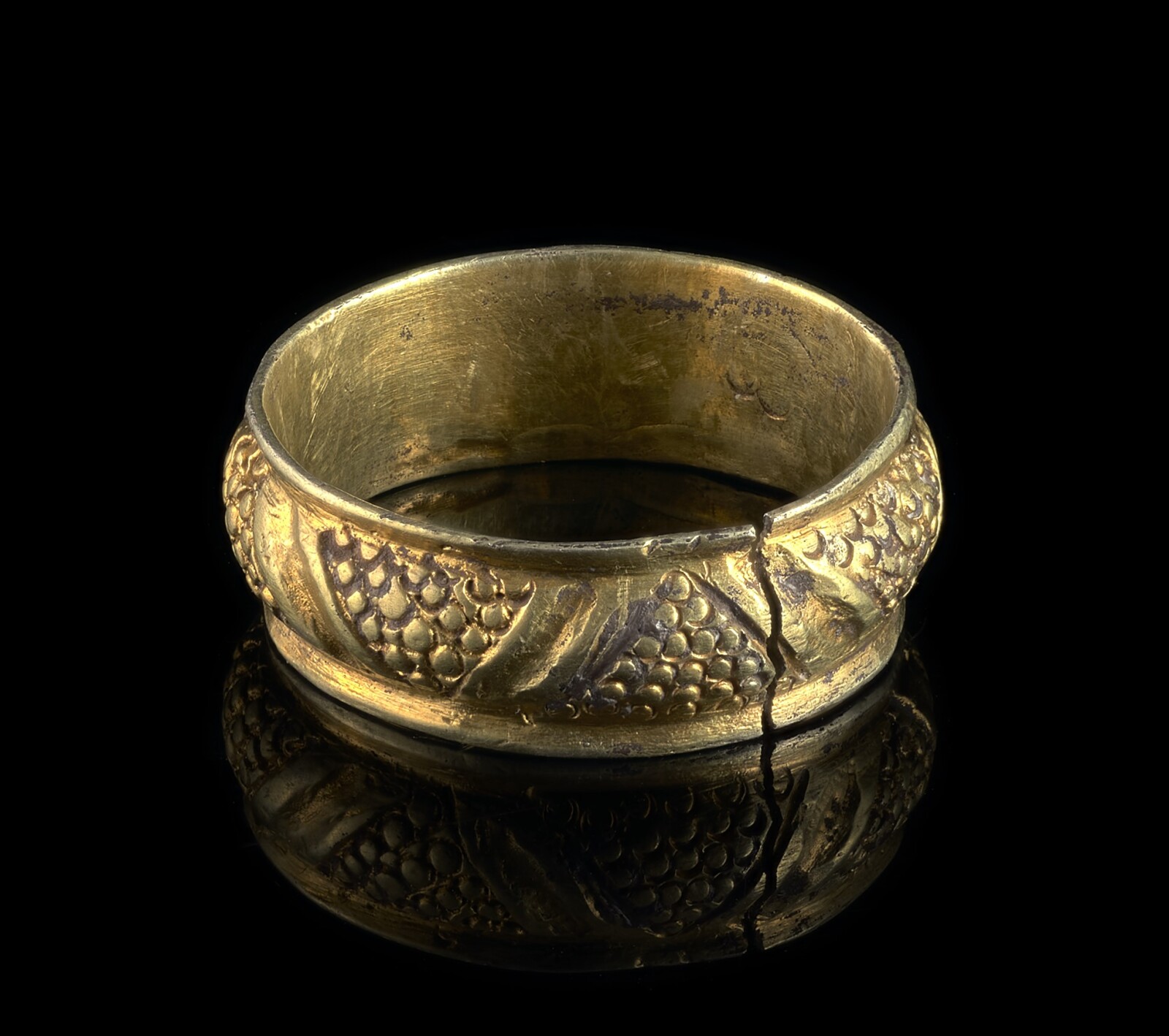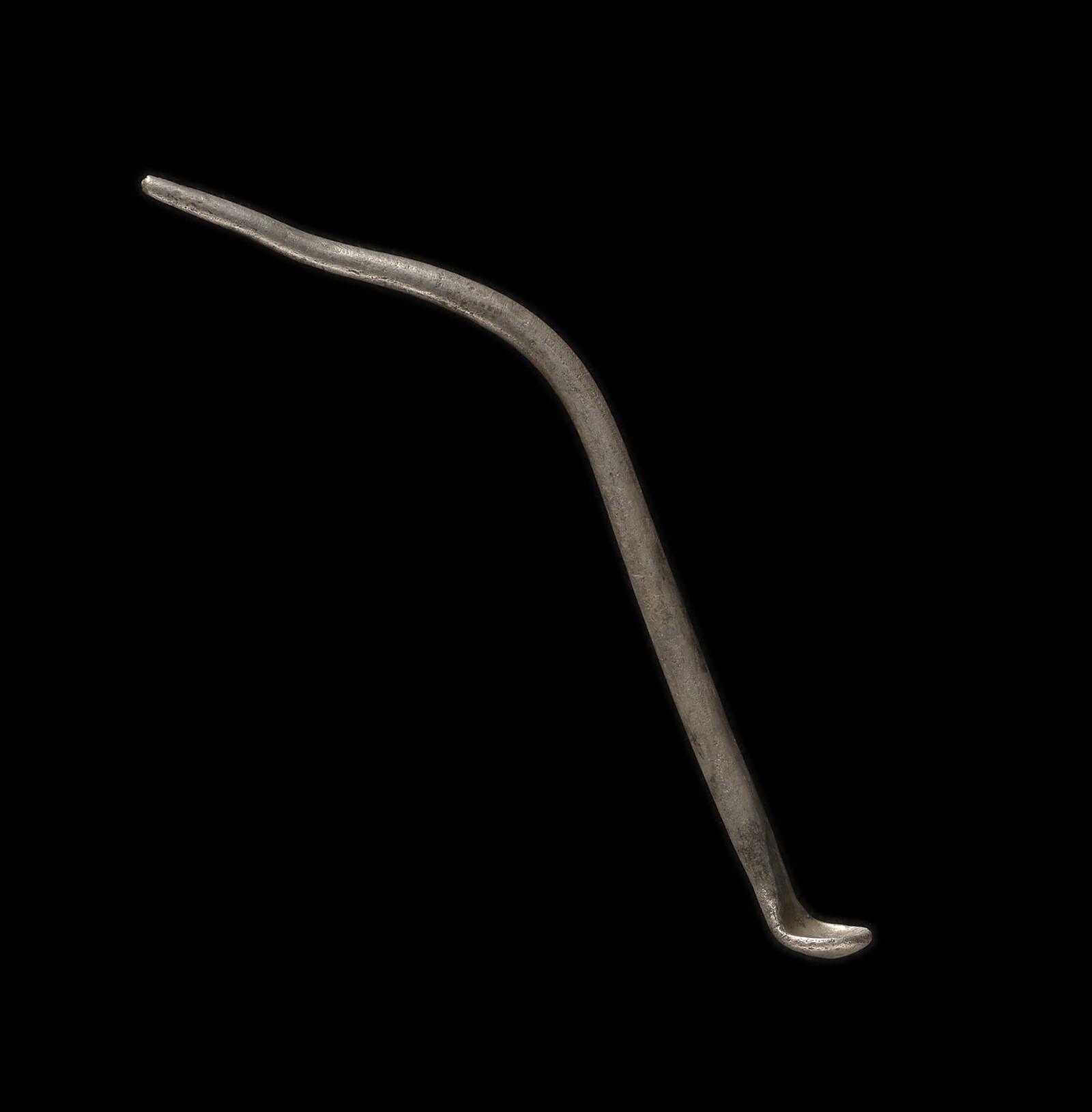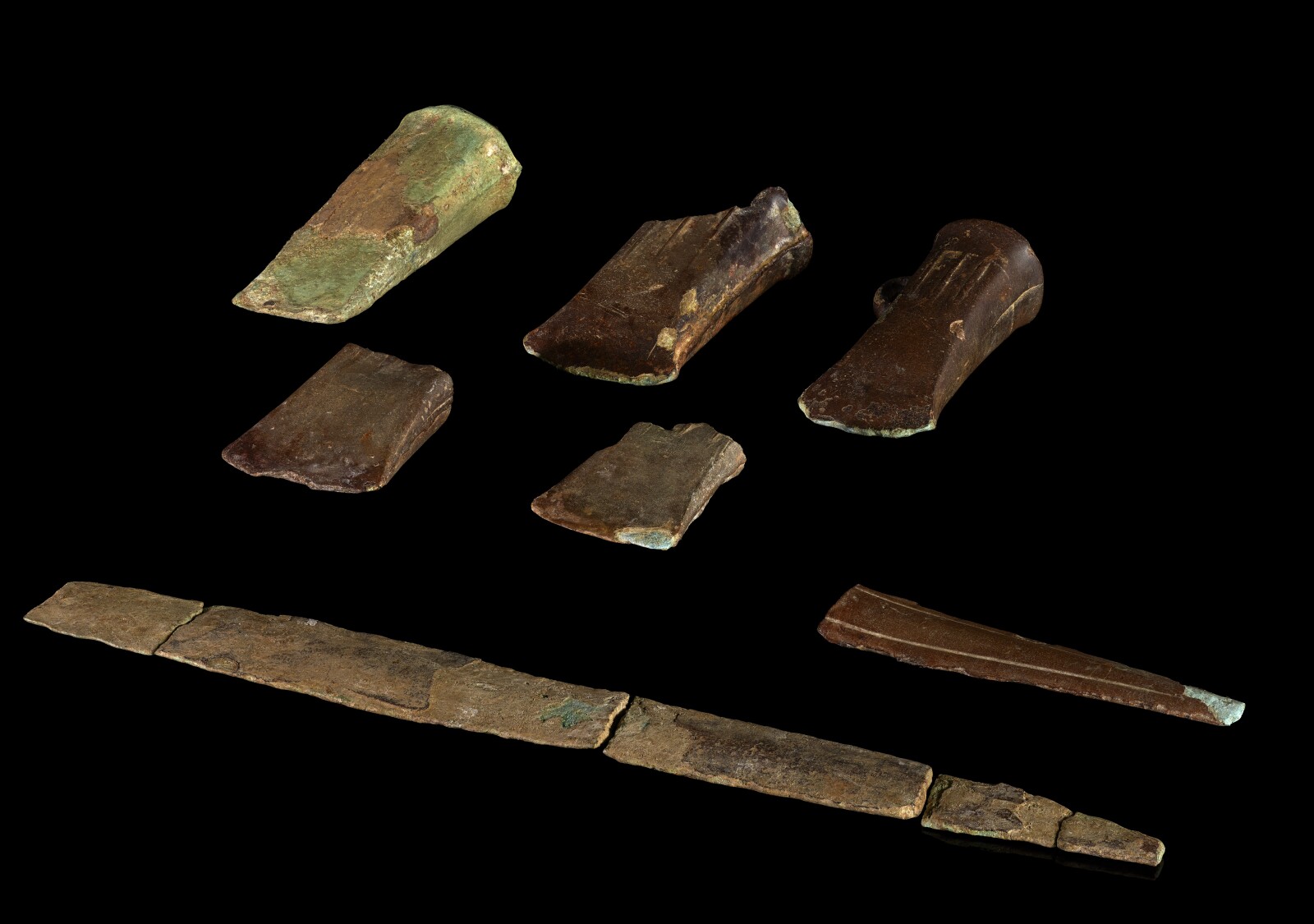Press Releases
Some Things Old, Some Things New: Treasure found in South Wales and Powys
Date:
2024-01-25
Post-Medieval silver-gilt finger ring

Roman ligula (toilet spoon)

Bronze Age hoard of seven bronze artefacts
Six treasure finds, including a Roman silver toilet spoon, a Bronze Age hoard, and a Post- Medieval silver-gilt finger ring, were declared treasure on Thursday 25th January 2024 by H.M. Regional Coroner for South Wales Central area, Patricia Morgan.
A Roman ligula (toilet spoon) (Treasure Case 21.39) was found by Mr Valentinas Avdejevas whilst metal detecting in St Nicholas and Bonvilston Community, Vale of Glamorgan in June 2020. It was first reported to Mark Lodwick, Co-ordinator of the Portable Antiquities Scheme for Wales (PAS Cymru). As a treasure find, it was identified and reported on by Evan Chapman, Senior Curator of Archaeology at Amgueddfa Cymru – Museum Wales.
The small silver spoon has a circular bowl and a slender, tapering shaft. The spoon shaft and bowl was once straight, but has more recently been bent out of shape in two places. A variety of uses have been suggested for Roman ligulae, including the extraction of cosmetics and perfumes from long-necked bottles and their application to the face or body, the extraction and application of medicines, and their use during medical procedures.
Silver ligulae, as opposed to the more common examples of copper alloy, are more frequently associated with these medical applications - possibly due to silver’s antimicrobial properties. This spoon contributes valuable archaeological evidence of medical knowledge and personal hygiene practices in Roman western Britain.
Cowbridge and District Museum has expressed an interest in acquiring this Treasure find after it has been independently valued via the Treasure Valuation Committee.
A Bronze Age hoard of seven bronze artefacts (Treasure Case 22.13) was discovered by Mr Mark Herman while metal-detecting in Pendoylan Community, Vale of Glamorgan on 8th September 2019. The discovery was also first reported to Mark Lodwick of PAS Cymru, and then reported as treasure by curators based at Amgueddfa Cymru – Museum Wales.
The hoard includes fragments from two bronze swords and five bronze socketed axes and dates to the Late Bronze Age, around 1000-800 BC. Amongst the axes are two examples with ribbed decoration which are identified as of South Wales Type. This distinctive regional axe is found in large numbers across south-east Wales in hoard groups and as single finds. Examples have also been found in north and west Wales, across southern England and in northern France, indicating long-distance metal exchange networks operated during the Late Bronze Age.
Chris Griffiths a PhD researcher with Amgueddfa Cymru – Museum Wales and the University of Reading, said:
"This hoard is unusual as it contains fragments from two swords, one of which is a blade tip fragment with decorative grooves which was made in north-western France. This small sword fragment therefore forms a key part of a much wider story, connecting those people who lived in Pendoylan Community with those who lived in north-western France, around 3,000 years ago."
Adam Gwilt, Principal Curator of Prehistory at Amgueddfa Cymru – Museum Wales said:
“In recent years, large numbers of hoards have been discovered across south-east Wales by finders through metal-detecting, particularly along the valley of the River Ely and its tributaries. Acquiring this hoard for the national collection will help us to tell stories about the people who made, used and carefully buried these prized metal objects”.
Amgueddfa Cymru – Museum Wales is keen to acquire this hoard, after it has been independently valued via the Treasure Valuation Committee.
A Post-Medieval silver-gilt finger ring (Treasure Case 23.42) was found by Mr Carlton Sheath in August 2023, while metal-detecting in Duhonw Community, Powys. The find was handed over to Felicity Sage, Historic Environment Record Manager at Dyfed Archaeological Trust before being couriered to Amgueddfa Cymru – Museum Wales for identification and reporting by Sian Iles, Curator of Medieval & Later Archaeology.
This decorative finger ring of silver and with gilded surfaces is decorated with 8 beaded panels divided by diagonal bands set in a zig-zag pattern. The style of beading seen in the panels is sometimes described as a ‘brambling’ effect. Although the gilding has endured on most of the ring’s surface, there is some wear visible along the borders.
This form is consistent with Post Medieval and early 16th century date. Most notably, a ring with similar zigzag banding and brambled panels was recovered from the wreck of the Mary Rose ship, which sank in 1545. Similar examples with brambled decoration have also previously been reported as treasure in Essex, Norfolk, and Powys. Together, these rings build a clearer picture about styles of adornment and craftsmanship across Tudor England and Wales.
Sian Iles, Curator of Medieval and Later Archaeology, Amgueddfa Cymru – National Museum Wales comments:
“This decorative silver-gilt finger ring is a fine example of a type popular in the fifteenth and sixteenth centuries. Thanks to the Portable Antiquities Scheme and the provisions of the Treasure Act, as well as prompt reporting by the finder, objects such as this are recorded, contributing greatly to our growing understanding of fashion and style in late medieval and early Tudor Wales.”
Y Gaer Museum, Art Gallery & Library in Brecon has expressed an interest in acquiring this Treasure find after it has been independently valued via the Treasure Valuation Committee.
David Howell, Engagement Officer for the Portable Antiquities Scheme in Wales (PAS Cymru) comments:
“The Portable Antiquities Scheme provides a vital link between metal detectorists, and museum communities. Recording artefacts found through metal detecting helps safeguard knowledge and information about Welsh heritage. Most treasure finds will first be shown and handed over to highly skilled Finds Liaison Officers, who are located throughout Wales.”
Also declared Treasure were:
- A Roman coin hoard comprising sixteen copper alloy coins (Treasure Case 21.43) found by Mr Andrew Ellis in February 2019 while metal-detecting in Llancarfan Community, Vale of Glamorgan. Cowbridge and District Museum has expressed an interest in acquiring this find after it has been independently valued via the Treasure Valuation Committee.
- A Medieval silver annular brooch with a dagger-shaped pin (Treasure Case 21.51), found by Mr Alexander Savage on 5th December 2021 during a metal-detecting rally in Penllyn Community, Vale of Glamorgan. Cowbridge and District Museum has expressed an interest in acquiring this find after it has been independently valued via the Treasure Valuation Committee.
- A Roman silver coin (denarius) of Emperor Domitian (Treasure Case 21.58) was found by Mr Andrew Arthur on 3rd February 2019 while metal-detecting in Vaynor Community, Merthyr Tydfil . This coin belongs to the same find as the Vaynor Community coin hoard (Treasure Case 17.28), consisting of a further 5 silver Roman denarii. Cyfarthfa Castle & Art Gallery has expressed an interest in acquiring this Treasure find after it has been independently valued via the Treasure Valuation Committee.
Amgueddfa Cymru belongs to everyone and is here for everyone to use. We are a charity and a family of seven national museums and a collections centre, located across the country. Our aim is to inspire everyone through Wales’ story, at our museums, in communities and digitally.
Our welcome is free thanks to funding from the Welsh Government and extends to people from all communities.
Play your part in Wales’ story: by visiting, volunteering, by joining, by donating.
Ends
For further information please contact:
Ellie Johnston
Marketing Communications Support Officer
Elena.Johnston@museumwales.ac.uk
Follow Amgueddfa Cymru’s seven museums on X, Instagram or Facebook.
EDITOR’S NOTES
1. All images to be credited © Amgueddfa Cymru – Museum Wales
2. The Portable Antiquities Scheme in Wales (PAS Cymru) is a mechanism to record and publish archaeological finds made by members of the public. It has proved a highly effective means of capturing vital archaeological information, while engaging with non-traditional museum audiences and communities.
3. Each year, between 50 and 80 treasure cases are reported in Wales, as finds made by members of the public, usually metal detectorists. Since 1997, over 700 treasure finds have been made in Wales, with numbers of treasure finds gradually increasing over time, with 77 treasure cases reported in 2023. These finds are adding important new knowledge and understanding of our pasts, a cultural resource of growing importance for Wales.
4. Treasure items must be legally reported and handed over to PAS Cymru staff and Amgueddfa Cymru – Museum Wales, as the lead heritage organisation managing treasure work in Wales. National museum curators gather accurate information and report on treasure finds, making recommendations to coroners, the officers who make independent legal judgements on treasure and ownership.